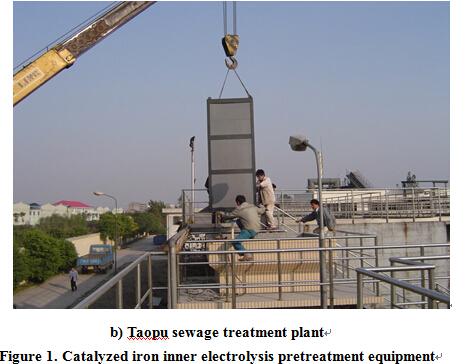Catalytic iron tech in industrial wastewater treatment
chinagate.cn, March 23, 2015 Adjust font size:

Although the catalytic iron inner electrolysis technology succeed in bend-scale test, pilot test and full-scale test, it still has a large number of practical problems need to be studied before it being applied to practical production, for example the form of reactor and filter unit, life time estimation, way of falling slag and cost estimates fouling of electrodes and so on.
For water quality of Taopu plant, when the reaction time is 2 hours, iron consumption is about 40 mg/L. According to the bulk density of the catalytic iron beds, the complete depletion life of iron is 30 months. But the equipment should stop running before the iron shavings completely depleted, thus it required to replace a section of the media every 12 months, and new iron shavings need to be added and re-mixed. For general water quality, surface corrosion of iron does not passivate, but also produce self-catalysis under certain circumstances. Therefore, iron corrosion does not affect the reaction effect. Similarly, effects of the filter units should not be dropped after the update.
The investment of Taopu plant increases about 300 Yuan/m3 when using catalytic iron inner electrolysis as a pretreatment process. Direct costs mainly come from power consumption and iron losses. Energy consumption of Taopu plant’s wastewater treatment is 0.05 KWh/m3. The direct cost of wastewater pretreatment is about 0.13 Yuan/m3.
In anoxic conditions (DO <0.5 mg/L), effect of catalysis of iron for organic matter reduction is improved while coagulation effect is weak, color removal effect is more obvious, the average removal rate is 42%; and COD removal is low, usually around 14%, phosphate removal is up to 57.0%. The color of effluent is generally pale yellow, with little total iron. In aerobic conditions (DO is 5.3-5.9 mg/L), effect of catalysis of iron for organic matter reduction is weak while coagulation effect is improved, COD removal efficiency improved significantly, which can be up to 44.0%, average color removal is 34%, lower than anoxic conditions , phosphate removal can be up to 87.5%. Under aerobic conditions (DO 0.9-1.4 mg/L), COD removal rate is relatively high, generally up to 54.5%, color removal rate can reach 43%, phosphate removal rate is up to 71.2%, which is an ideal working conditions.

